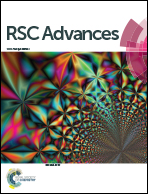Superhydrophilicity and spontaneous spreading on zwitterionic surfaces: carboxybetaine and sulfobetaine†
Abstract
Zwitterionic surfaces are fabricated by grafting sulfobetaine silane (SBSi) and carboxybetaine silane (CBSi) on glass slides. Their wetting behaviors are investigated using water, polar organic liquids, and hexadecane as test liquids. For the CBSi surface, partial wetting is observed, and contact angles of water and hexadecane are lower than 10°, revealing super-amphiphilicity. For the SBSi surface, all test liquids spread spontaneously and contact angles are absent, corresponding to total wetting. The time evolution of the wetting area of a liquid drop can be divided into three types: spread-withdrawal for water, spread-pin for polar organic liquids, and continuous spread for hexadecane. The spontaneous spreading on SBSi surfaces is driven by the high solid–gas interfacial tension and can be characterized by the power law. Although zwitterionic surfaces like both water and hexadecane in ambient air, their preference for water over hexadecane is typically demonstrated by a hexadecane drop in a water environment. Nonetheless, the contact angle of the hexadecane drop is 120° on the CBSi surface, but becomes 180° on the SBSi surface. As the zwitterionic surfaces are immersed in all test liquids, bubbles generally adhere to the CBSi surface but freely move beneath the SBSi surface. Our experimental results clearly show the wettability difference between the CBSi and SBSi surfaces. The former is superhydrophilic, while the latter is total wetting.


 Please wait while we load your content...
Please wait while we load your content...